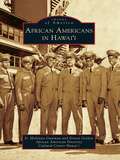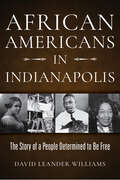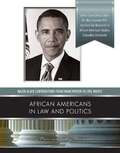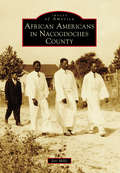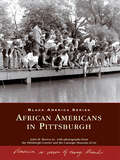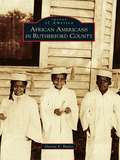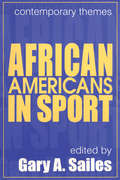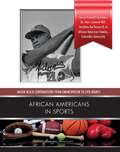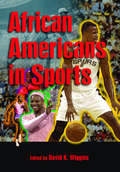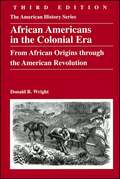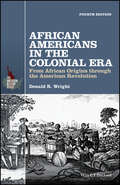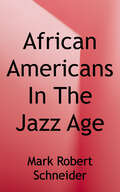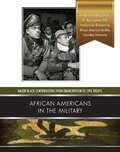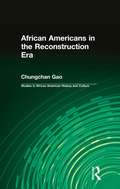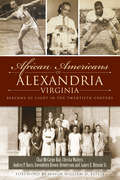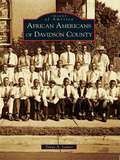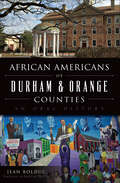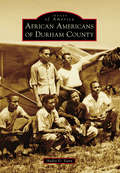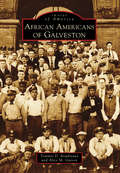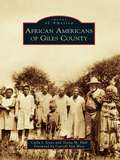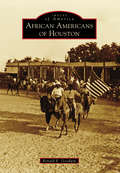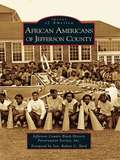- Table View
- List View
African Americans in Hawai'i (Images of America)
by D. Molentia Guttman African American Diversity Cultural Center Hawai'i Ernest GoldenDuring the early 1800s, about two dozen men of African descent lived in Hawai'i. The most noteworthy was Anthony D. Allen, a businessman who had traveled around the world before making Hawai'i his home and starting a family there in 1810. The 25th Black Infantry Regiment, also known as the Buffalo Soldiers, arrived in Honolulu at the Schofield Barracks in 1913. They built an 18-mile trail to the summit of Mauna Loa, the world's largest shield volcano, and constructed a cabin there for research scientists. After World War II, the black population of Hawai'i increased dramatically as military families moved permanently to the island. Hawai'i has a diverse population, and today about 35,000 residents, approximately three percent, claim African ancestry.
African Americans in Indianapolis: The Story of a People Determined to Be Free
by David L. WilliamsIndianapolis has long been steeped in important moments in African American history, from businesswoman Madame C. J. Walker's success to the rise of the Ku Klux Klan to the founding of Crispus Attucks High School, which remained segregated through the 1960s.In African Americans in Indianapolis, author and historian David Leander Williams explores this history by examining the daunting and horrendous historical events African Americans living in Indianapolis encountered between 1820 and 1970, as well as the community's determination to overcome these challenges. Revealing many events that have yet to be recorded in history books, textbooks, or literature, Williams chronicles the lives and careers of many influential individuals and the organizations that worked tirelessly to open doors of opportunity to the entire African American community. African Americans in Indianapolis serves as a reminder of the advancements that Black midwestern ancestors made toward freedom and equality, as well as the continual struggle against inequalities that must be overcome.
African Americans in Law and Politics (Major Black Contributions from Emancipat)
by Mary MainOn November 4, 2008, Americans went to the polls and elected the first black president in the history of the United States. Barack Obama was clearly a gifted politician with impressive achievements and a compelling life story. Still, his historic election wouldn't have been possible if earlier generations of African Americans hadn't paved the way. This book tells the stories of pioneering African-American lawyers and politicians. It details their efforts to guarantee black people the same rights enjoyed by other Americans, including the right to vote. In courtrooms, statehouses, and the halls of Congress, the people profiled in this book have helped make the United States what the framers of the Constitution hoped: "a more perfect Union."
African Americans in Memphis (Images of America)
by Earnestine Lovelle JenkinsMemphis has been an important city for African Americans in the South since the Civil War. They migrated from within Tennessee and from surrounding states to the urban crossroads in large numbers after emancipation, seeking freedom from the oppressive race relations of the rural South. Images of America: African Americans in Memphis chronicles this regional experience from the 19th century to the 1950s. Historic black Memphians were railroad men, bricklayers, chauffeurs, dressmakers, headwaiters, and beauticians, as well as businessmen, teachers, principals, barbers, preachers, musicians, nurses, doctors, Republican leaders, and Pullman car porters. During the Jim Crow era, they established social, political, economic, and educational institutions that sustained their communities in one of the most rigidly segregated cities in America. The dynamic growth and change of the post-World War II South set the stage for a new, authentic, black urban culture defined by Memphis gospel, blues, and rhythm and blues music; black radio; black newspapers; and religious pageants.
African Americans in Nacogdoches County (Images of America)
by Jeri MillsTypical of most communities after the Civil War, Nacogdoches's African Americans had to repurpose their lives by building their own communities while they carved a life of survival first and progress second. The images in this book will tell the stories of the first churches and how they became the center of the community. Other images will share information about the early leaders in the community who helped establish educational facilities for "Negroes." Additional images focus on black businesses, and a final set of images will discuss the emerging black middle class and others who played significant roles in Nacogdoches history. Readers of this book will go on a journey, through images, that highlights residents' pains of struggles and gains of triumph.
African Americans in Pittsburgh (Black America Series)
by Carnegie Museum of Art Pittsburgh Courier John M. Brewer Jr.African Americans in Pittsburgh chronicles the distinct trends in this African American community. There was never one centralized neighborhood where a majority of the black population lived, and city schools were integrated until after desegregation laws were passed. Photographs captured by famed Pittsburgh photographer Charles "Teenie" Harris show the candid experiences of residents, including the achievements and celebrations of people struggling to put scraps of food on the table.
African Americans in Radio, Film, and TV Entertainers (Major Black Contributions from Emancipat)
by Linda J. ArmstrongThis book is filled with fascinating stories, from the night a shy young woman's play changed Broadway to the day the most successful talk show host in history got her start. Find out about the stage actor who once earned letters in four college sports--and who won academic honors, too. Follow the triumphs and disappointments of some of the most famous black entertainers in our nation's history. Rediscover great personalities who have been forgotten. And learn about how the roles of black performers both changed with and helped changed American society.
African Americans in Rutherford County (Images of America)
by Devora E. ButlerAfrican Americans have heavily contributed to and shaped the unique and vibrant Rutherford County in middle Tennessee. Located 30 miles southeast of Nashville, Rutherford County is at the state's geographical center. This area is home to the Stones River National Battlefield, a national park that was the site of a major Civil War battle--the Battle of Stones River. Tourists come from all over the world to experience this rich cultural and historic venue that once served, although briefly, as the capital of Tennessee. African American men and women have lived, worked, and toiled here for generations.
African Americans in Sports
by Gary A. SailesResearch on African American athletes generally fo-cuses on negative stereotypes of physical prowess, and socially controversial themes. Most studies in-vestigate racism, prejudice, discrimination, and ex-ploitation experienced by African American athletes. Many studies contrast African American and white athletes on a number of variables that support pre-vailing elitist stereotypes and denigrate African Ameri-can athletes. But few studies investigate the diverse and complex cultural dichotomies within the infrastruc-ture of sport in the African American community. Gary Sailes maintains that it is crucial to develop a more eclectic and immersed cultural approach when investigating African American involvement in com-petitive sports. The contributors to 'African Americans in Sports' show that there are also intrinsic cultural paradigms that are evident, presenting an informa-tive and interesting narrative regarding African American athletes. The chapters that make up this volume were written by noted scholars who were selected based on their expertise in their specific academic areas. They write about different components of the experience of African American male athletes. Chapters and contributors include: "Race and Athletic Performance: A Physiological Review" by David W. Hunter; "The Athletic Dominance of African Americans--Is There a Genetic Basis?" by Vinay Harpalani; "African American Player Codes on Celebration, Taunting, and Sportsmanlike Conduct" by Vernon L. Andrews; and "Stacking in Major League Baseball" by Earl Smith and C. Keith Harrison. Many chapters were originally published as a special issue of the 'Journal of African American Men.' This volume should be read by all those involved in athletics, as well as by sports sociologists and African American studies scholars.
African Americans in Sports (Major Black Contributions from Emancipat)
by James NasiumThis book profiles some of the greatest African-American athletes of the past 150 years. They competed in sports ranging from boxing and horse racing to track and field, basketball, and baseball. As you'll discover, what these champions accomplished on the field of competition was often but a small part of their story. Read, for example, about how doctors thought Wilma Rudolph might never walk after a childhood bout of polio--but she went on to sprint her way to three Olympic gold medals. Or how the fiery Jackie Robinson silently endured a torrent of abuse in order to break baseball's "color barrier." Find out the connection between a stolen bike and Muhammad Ali's legendary boxing career. And learn how the African-American sports heroes of the past helped pave the way for superstars of the present, such as Kobe Bryant, Tiger Woods, and Candace Parker.
African Americans in Sports: African Americans In Sports
by David K. WigginsThis two-volume set features 400 articles on African-Americans in sports, including biographical entries as well as entries on events, tournaments, leagues, clubs, films, and associations. The entries cover all professional, amateur, and college sports such as baseball, tennis, and golf.
African Americans in U.S. Foreign Policy: From the Era of Frederick Douglass to the Age of Obama
by Linda Heywood Allison Blakely Charles Stith Joshua C. YesnowitzBookended by remarks from African American diplomats Walter C. Carrington and Charles Stith, the essays in this volume use close readings of speeches, letters, historical archives, diaries, and memoirs of policymakers and newly available FBI files to confront much-neglected questions related to race and foreign relations in the United States. Why, for instance, did African Americans profess loyalty and support for the diplomatic initiatives of a nation that undermined their social, political, and economic well-being through racist policies and cultural practices? Other contributions explore African Americans' history in the diplomatic and consular services and the influential roles of cultural ambassadors like Joe Louis and Louis Armstrong. The volume concludes with an analysis of the effects on race and foreign policy in the administration of Barack Obama. Groundbreaking and critical, African Americans in U.S. Foreign Policy expands on the scope and themes of recent collections to offer the most up-to-date scholarship to students in a range of disciplines, including U.S. and African American history, Africana studies, political science, and American studies.
African Americans in the Colonial Era: From African Origins through the American Revolution
by Donald R. WrightOver recent decades few topics of American history have been subject to greater attention and more thorough revision than African Americans in colonial times. Acclaimed works by leading scholars, relying on new bodies of evidence and writing from a fresh, Atlantic perspective, have provided a broadened, more nuanced view of the topic. In this third edition of one of the most popular books in our American History Series, Donald Wright works new interpretations into a narrative that provides a clear understanding of the scope and nature of the early African-American experience. Included are discussions of African Americans African origins; the Atlantic slave trade, based on the latest data from an on-line Trans-Atlantic Slave Trade Database; the origins of slavery and race-based prejudice in the mainland colonies; the evolutionary formation of African-American culture; and the effects of the American Revolution on men and women of African descent, at the time and long thereafter. This third edition views African Americans in the British North-American mainland colonies more as their contemporaries did: as persons from one of the four continents who interacted economically, socially, and politically over a period of 180 years in a vast, vibrant, complex Atlantic world. It shows how the mainland North-American society that resulted from these interactions reflected the mix of Atlantic cultures and how the republic that a group of these people eventually constructed used European ideas to support creation of a favorable situation for those in control, persons largely of European descent. The African and African-American men and women, whose forebears had added greatly to the region s economic and cultural viability, found themselves in 1789 with the least benefit from the nation they helped bring into existence. Of special value is the book s bibliographical essay, an expansion and updating of earlier versions that led the historian Ira Berlin to label Wright the historiographer of slavery in the early period.
African Americans in the Colonial Era: From African Origins through the American Revolution (The American History Series #32)
by Donald R. WrightWhat are the origins of slavery and race-based prejudice in the mainland American colonies? How did the Atlantic slave trade operate to supply African labor to colonial America? How did African-American culture form and evolve? How did the American Revolution affect men and women of African descent? Previous editions of this work depicted African-Americans in the American mainland colonies as their contemporaries saw them: as persons from one of the four continents who interacted economically, socially, and politically in a vast, complex Atlantic world. It showed how the society that resulted in colonial America reflected the mix of Atlantic cultures and that a group of these people eventually used European ideas to support creation of a favorable situation for those largely of European descent, omitting Africans, who constituted their primary labor force. In this fourth edition of African Americans in the Colonial Era: From African Origins through the American Revolution, acclaimed scholar Donald R. Wright offers new interpretations to provide a clear understanding of the Atlantic slave trade and the nature of the early African-American experience. This revised edition incorporates the latest data, a fresh Atlantic perspective, and an updated bibliographical essay to thoroughly explore African-Americans’ African origins, their experience crossing the Atlantic, and their existence in colonial America in a broadened, more nuanced way.
African Americans in the Jazz Age: A Decade of Struggle and Promise
by Mark Robert SchneiderThe victorious end to the first World War offered hope to African Americans who had fought for freedom abroad and hoped to find it at home. In this new work, historian Mark R. Schneider analyzes the dynamic 1920s that saw the enormous migration of African Americans to Northern urban centers and the formation of important <p><p>African American religious, social and economic institutions. Yet, even with considerable efforts to promote civil rights and advancements in the arts, many African Americans in the rural south continued to live under conditions unchanged from a century before. African Americans in the Jazz Age recounts the history of this turbulent era, paying particular attention to the ways in which African Americans actively challenged Jim Crow and firmly expressed pride in their heritage. <p><p>Supplemented by primary sources, this work serves as an ideal introduction to this critical period in U.S. history and allows students to examine the issues first-hand and draw their own conclusions.
African Americans in the Military (Major Black Contributions from Emancipat)
by Marcia Amidon LustedAfrican Americans have participated in all of the country's major conflicts, from the Revolutionary War to the present. Their contributions were vital and their courage on the battlefield commendable. Often, however, the nation was less than grateful. This book tells the story of blacks in the U.S. military. It is a story of courage and honor--a story that will both fascinate and inspire.
African Americans in the Reconstruction Era (Studies in African American History and Culture)
by Chungchan GaoFirst published in 2000. Routledge is an imprint of Taylor & Francis, an informa company.
African Americans of Alexandria, Virginia: Beacons of Light in the Twentieth Century (American Heritage)
by Christa Watters James E. Henson Sr. Audrey P. Davis Gwendolyn Brown-Henderson Char McCargo BahSitting just south of the nation's capital, Alexandria has a long and storied history." "Still, little is known of Alexandria's twentieth-century African American community. Experience the harrowing narratives of trials and triumph as Alexandria's African Americans helped to shape not only their hometown but also the world around them. Rutherford Adkins became one of the first black fighter pilots as a Tuskegee Airman. Samuel Tucker, a twenty-six-year-old lawyer, organized and fought for Alexandria to share its wealth of knowledge with the African American community by opening its libraries to all colors and creeds. Discover a vibrant past that, through this record, will be remembered forever as Alexandria's beacon of hope and light.
African Americans of Davidson County (Images of America)
by Tonya A. LanierAfrican Americans were present in Davidson County long before it was officially formed from Rowan County in 1822. The exact time or place of settlement remains in question. They served not only in the stereotypical roles of farm laborers and house slaves but also as skilled traders, blacksmiths, furniture makers, and artisans. From Petersville, Southmont, Thomasville, Midway, Lexington, Belltown, Reeds, Churchland, and tiny areas in between, great men and women found a sense of stability. They made a life out of the scraps that were left behind. This collection of historical photographs is a textured look at African Americans in Davidson County. Images of community notables like A. B. Bingham, Charles England, Rev. A. T. Evans, and Etta Michael White and iconic structures like St. Stephen United Methodist Church, Dunbar High School, and the Hut, these photographs weave together stories that outline the African American journey.
African Americans of Durham & Orange Counties: An Oral History (American Heritage)
by Jean BolducDurham and Orange Counties have vibrant and active African American communities. Throughout the region's unjust past, generations have shown extraordinary strength and resolve. Floyd McKissick became the first African American student at the University of North Carolina School of Law after Thurgood Marshall argued for his admittance in court. The struggle for civil rights in Durham shaped the poetry of Jaki Shelton Green, one of the state's most esteemed wordsmiths. More recently, local leaders such as Michelle Johnson find the work of equality is far from over. Journalist and writer Jean Bolduc reveals the voices of Durham and Orange County African Americans in a series of inspirational oral histories.
African Americans of Durham County (Images of America)
by Andre D. VannDurham County, North Carolina, once called the “Chicago of the South” and the “Capital of the Black Bourgeoisie,” has long occupied an important place in the hearts and minds of those who called Durham County home. African Americans have played a vital role in the growth and development of the region over the years, from antebellum times to Reconstruction to the Civil Rights era and in the present. The African American citizens of this historic Tar Heel county share an impressive story marked by determination, economic achievement, and resilience, and they have made a difference in all walks of life—educational, religious, civic, and commercial. This pictorial history reflects upon the rich and vibrant role that African Americans played in the area following emancipation. In its earliest stages, residents in such neighborhoods as Hayti, Hickstown, Crest Street, Pearsontown, the West End, the East End, and Walltown each created sturdy surviving communities that have shaped Durham.
African Americans of Galveston (Images of America)
by Tommie D. Boudreaux Alice M. GatsonIn the 19th century, Galveston shores were a gateway for immigrants to Texas and destinations beyond. Slaves, the forced immigrants, were brought to Galveston as property for sale. The largest slave trade operation in Galveston was implemented by Jean Laffite, a pirate. His slave trade business began around 1818. However, for the most part, slaves entering the port of Galveston were destined for other Texas cities and other states. Images of America: African Americans of Galveston presents the community life and accomplishments of Galveston slaves, the descendants of slaves, and descendants of those who migrated to Galveston after the Civil War. The book celebrates Galveston's African American culture from the 1840s to the 1960s.
African Americans of Giles County (Images of America)
by Carroll Van West Tonya M. Hull Carla J. JonesGiles County was founded on November 14, 1809, and is known as the land of milk and honey. The county is home to over 30 National Register properties, Civil War skirmish sites, a varied cultural heritage, and intersecting Trail of Tears routes (Benge's and Bell's). It is also the beginning place for many well-known African Americans, such as noted architect Moses McKissack, founder of McKissack and McKissack. Giles County is a place where many ancestral lineages return home to their roots for research or to discover their rich African American history and heritage.
African Americans of Houston (Images of America)
by Ronald E. GoodwinTexas is a Southern state, and in many ways, Houston is a typical Southern city. While Houston did not experience the types or degrees of racial violence found in other Southern cities during the Jim Crow era, black Houstonians nonetheless found themselves often relegated to the margins of society. For decades there were two distinct Houstons: one white and the other black. However, Houston's black community created businesses that flourished and schools that educated children and developed a culture that celebrated the accomplishments of their parents while eagerly anticipating the accomplishments of future generations. Images of America: African Americans of Houston captures the many facets of black Houston. From churches to nightclubs; city parks to city hall; and political giants Barbara Jordan, Mickey Leland, and Sheila Jackson Lee to the driving beats of Archie Bell and the Drells, the Ghetto Boys, and Beyoncé, black Houston is alive with a determination that past injustices will never dampen the future opportunities for greatness.
African Americans of Jefferson County (Images of America)
by Inc. Sen. Robert Byrd Jefferson County Black History Preservation SocietyJefferson County can proudly claim a large number of firsts when it comes to African Americans in national history. The raid to free slaves that served as a catalyst for the Civil War was led by abolitionist John Brown in Harpers Ferry. The first man wounded in the rebellion was Heyward Shepherd, a free African American and a Jefferson County resident. Pres. Abraham Lincoln appointed Jefferson County native Martin Robison Delany as the first African American field officer of the Civil War. In 1906, the Niagara Movement, forerunner to the National Association for the Advancement of Colored People (NAACP), held its first meeting on American soil on the Storer College campus. The first woman to become the coach of a men's college basketball team was also an African American from Jefferson County. Additionally, the Colored Horse Show held in Charles Town was the first of its kind for African Americans.
